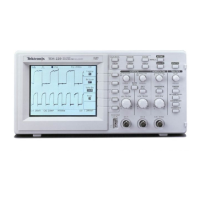TDS7104 & TDS7054 Service Manual
3-1
Theory of Operation
This section describes the electrical operation of the oscilloscope. Figure 9--1 on
page 9--2 shows the module interconnections.
Logic Conventions
The oscilloscope contains many digital logic circuits. This manual refers to these
circuits with standard logic symbols and terms. Unless otherwise stated, all logic
functions are described using the positive-logic convention: the more positive of
the two logic levels is the high (1) state, and the more negative level is the low
(0) state. S ignal states may also be described as “true” meaning their active state
or “false” meaning their nonactive state. The specific voltages that constitute a
high or low s tate vary among the electronic devices.
Module Overviews
Module overviews describes the basic operation of each functional circuit block
asshowninFigure9--1onpage9--2.
A dual-processor system controls the oscilloscope. The oscilloscope features a
VGA resolution flat-panel display, a transparent touch screen, and a front-panel
with direct access to commonly used oscilloscope functions. You can also use
the oscilloscope with a mouse pointing device or keyboard.
A s ignal enters the oscilloscope through a direct coaxial connection to the input
connector, or a probe connected to the front panel.
Acquisition Board. The acquisition board conditions the input signals, samples
them, converts them to digital signals, and controls the acquisition process under
direction of the processor system. The acquisition system includes the multi-
source trigger, acquisition timebase, and acquisition mode generation and control
circuitry. The acquisition board is located in the bottom compartment of the
oscilloscope. Four vertical channels are accommodated. All channels feature a
Tekprobe Level 2 interface for additional front-end signal conditioning functions
like high input-impedance real-time probes.
Processor System. The processor system contains two processor boards with
microprocessors that control the entire oscilloscope. The basic configuration
supports four input channels labeled Ch 1 through Ch 4, provides an external
General
Input Signal Path

